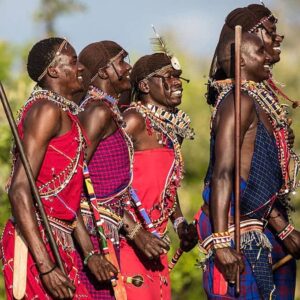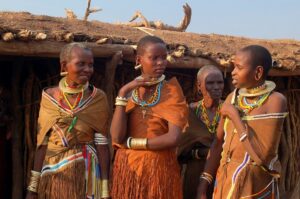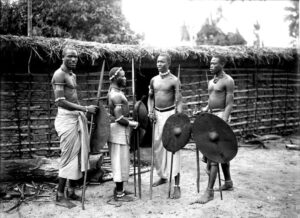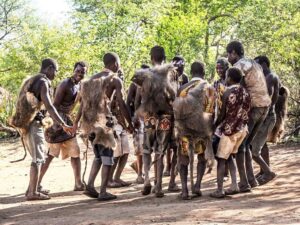Meet our Neighbors
MAASAI TRIBE

The Maasai are a semi-nomadic ethnic group in Tanzania and Kenya. They are known for their distinctive customs, dress and culture. They are a pastoralist people and rely heavily on their cattle for their livelihood. The Maasai have a deep connection to the land and have a unique relationship with the environment and wildlife around them.
The Maasai have a strong sense of community and have a traditional hierarchy, with the elders and leaders playing an important role in decision making. They have a rich cultural heritage and have been able to maintain their traditional customs and practices despite the challenges of modernization. The Maasai are known for their distinctive customs, such as the jumping dance which is a rite of passage for young men.
The Maasai people also have a unique traditional form of healing which is based on the use of plants and herbs. They have a deep understanding of traditional medicine and use natural remedies to treat various illnesses and ailments. They are also known for their unique and colorful dress, which includes red cloaks, beaded jewelry and ornate headdresses.
The Maasai culture is an important part of Tanzania’s cultural heritage, and many tourists visit the Maasai Mara and other areas to learn about their traditional way of life and customs. They are also known for their conservation efforts and have been working with various organizations to protect the wildlife and their land.
BARBAIG TRIBE

The Barabaig, are a semi-nomadic ethnic group in Tanzania. They are known for their pastoralist way of life and are primarily herders of cattle, sheep, and goats. The Barabaig are believed to have originated in the southern highlands of Ethiopia and migrated to Tanzania centuries ago. They have a rich cultural heritage and have been able to maintain their traditional customs and practices despite the challenges of modernization.
The Barabaig people have a unique social organization and a strong sense of community. They have a traditional hierarchy, with the elders and leaders playing an important role in decision-making. They also have a unique traditional ceremony known as the “Chaka” which is an important part of their cultural heritage.
The Barabaig people also have a unique traditional form of healing which is based on the use of plants and herbs. They have a deep understanding of traditional medicine and use natural remedies to treat various illnesses and ailments. The Barabaig people have a deep connection with the land and have a unique relationship with the environment and wildlife around them. They continue to maintain their traditional way of life and customs despite the challenges of modernization and globalization
HEHE TRIBE

The Hehe tribe is a Bantu ethnic group that is native to the Iringa region of Tanzania. They have traditionally been a farming people, growing crops such as maize, rice, and beans. They also have a rich cultural heritage, with a long history of oral tradition and storytelling. The Hehe people have a strong sense of community, and their traditional social organization is based on extended families and clans. They have a complex system of beliefs and rituals, which revolve around ancestor worship and the propitiation of spirits. The Hehe are also known for their traditional dances and music, which are an important part of their cultural heritage.
The Hehe people have a long history of resistance against colonialism and the slave trade. They are led by their legendary leader, Chief Mkwawa, who led the Hehe resistance against German colonial rule in the late 1800s. Despite their strong resistance, their land was eventually taken by the Germans and the tribe was forced to adapt to the new political and economic system. Today, the Hehe people continue to maintain their traditional customs and culture, while also participating in the modern economy of Tanzania. They are a proud and resilient people who have managed to preserve their heritage and continue to make valuable contributions to the culture and society of Tanzania.
HADZABE TRIBE

he Hadzabe tribe, also known as the Hadza or Watindiga, is an indigenous ethnic group in Tanzania. They are one of the last remaining hunter-gatherer tribes in Africa and are believed to be the direct descendants of the earliest human ancestors. The Hadzabe people have lived in the region for thousands of years and have a deep understanding and connection with the environment and wildlife around them. They have a unique culture, language and customs that have been passed down for generations.
The Hadzabe people live in small bands and subsist off hunting, gathering and fishing. They are skilled hunters and use traditional methods such as bow and arrows to catch their food. They also gather wild fruits, berries and tubers to supplement their diet. They live in harmony with nature and have a deep understanding of the plants, animals and natural resources around them. They also have a rich tradition of storytelling and music which is an important part of their cultural heritage.
The Hadzabe people are also known for their unique traditional healing practices and have a deep understanding of traditional medicine. They have a unique relationship with the land, and continue to live in harmony with nature, the land and the animals that surround them. The Hadzabe tribe is often considered as a living link to the past and they continue to maintain their traditional customs and culture despite the challenges of modernization and globalization.
